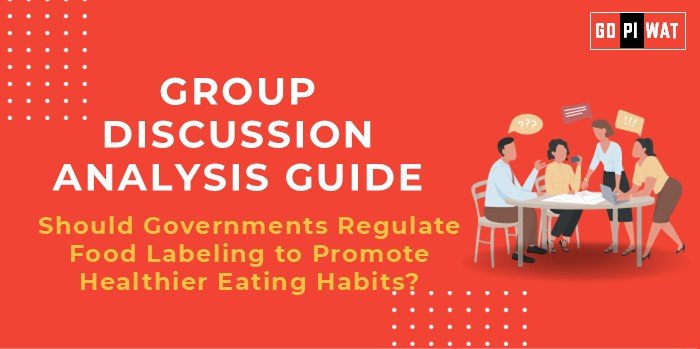📋 Group Discussion (GD) Analysis Guide: Should Governments Regulate Food Labeling to Promote Healthier Eating Habits?
🌐 Introduction to the Topic
📖 Opening Context
In an era where obesity and diet-related diseases like diabetes and hypertension are on the rise globally, food labeling has emerged as a critical tool to empower consumers with information. Governments worldwide are exploring regulatory measures to promote healthier eating habits through clear, transparent, and mandatory food labeling.
📜 Topic Background
The history of food labeling dates back to the 20th century, evolving from basic product identification to detailed ingredient lists, nutritional facts, and health warnings. Recently, countries like Chile and the UK have implemented aggressive labeling policies to combat poor dietary habits.
📊 Quick Facts and Key Statistics
- 🌍 Global Obesity Rates: Over 1 billion adults worldwide are obese, according to WHO (2023), highlighting the need for informed dietary choices.
- ⚕️ Chronic Diseases: 70% of deaths globally are due to non-communicable diseases, many linked to poor nutrition.
- 📉 Impact of Labeling: Studies indicate a 10-15% reduction in unhealthy food consumption after implementing clear labeling like “high in sugar” warnings.
- 🇮🇳 India’s Nutrition Scenario: 25% of the population is overweight, with growing cases of childhood obesity.
👥 Stakeholders and Their Roles
- Governments: Enforce labeling standards, ensure compliance, and educate the public.
- Food Industry: Comply with regulations and innovate healthier product options.
- Consumers: Use labels to make informed dietary choices.
- Healthcare Organizations: Advocate for policies and provide data on health impacts.
- Global Bodies (e.g., WHO): Offer guidelines and global best practices.
🎯 Achievements and Challenges
✅ Achievements
- 🇨🇱 Chile’s Model: Black label warnings for unhealthy foods reduced sugary drink consumption by 25% within a year.
- 🇬🇧 UK’s Traffic Light Labeling: Simplified nutrition information increased consumer awareness by 40%.
- 📈 Transparency Boost: Encourages manufacturers to reduce harmful ingredients.
🚧 Challenges
- ⚖️ Resistance from the Food Industry: Concerns over revenue loss and compliance costs.
- 📉 Consumer Awareness Gap: Many consumers lack nutritional literacy to interpret labels effectively.
- 🌍 Global Comparisons:
- Success: Sweden’s “Keyhole” label incentivizes healthier choices.
- Challenges: The US struggled with uniform adoption of food labeling across states.
🛠️ Structured Arguments for Discussion
- Supporting Stance: “Government regulation of food labeling is essential to combat rising health issues, as demonstrated by successful models in Chile and Sweden.”
- Opposing Stance: “Over-regulation can stifle industry growth and lead to higher food costs for consumers.”
- Balanced Perspective: “While regulation is necessary for public health, it should be complemented by education campaigns and industry collaboration.”
🗨️ Effective Discussion Approaches
📈 Opening Approaches
- Quote WHO statistics to emphasize urgency.
- Cite Chile’s success in reducing sugary drink consumption.
🔄 Counter-Argument Handling
- Address Industry Concerns: Use examples of mutual benefits from reformulation initiatives.
- Highlight Consumer Education: Advocate for education as a parallel strategy to labeling.
📋 Strategic Analysis of Strengths and Weaknesses
SWOT Analysis
- ✨ Strengths: Promotes public health, incentivizes healthier products, aligns with SDG goals.
- ⚠️ Weaknesses: Potential economic pushback, variable consumer understanding.
- 🚀 Opportunities: Integrating AI-powered smart labels, global harmonization of standards.
- ⚡ Threats: Resistance from powerful lobbies, misinformation campaigns.
🎓 Connecting with B-School Applications
🌍 Real-World Applications
Analyze food labeling strategies for case studies in marketing or public health projects.
💬 Sample Interview Questions
- “How can regulatory policies balance public health goals with industry interests?”
- “What are the economic implications of mandatory food labeling?”
💡 Insights for B-School Students
- Explore interdisciplinary themes, such as behavioral economics and policy impact on consumer habits.


